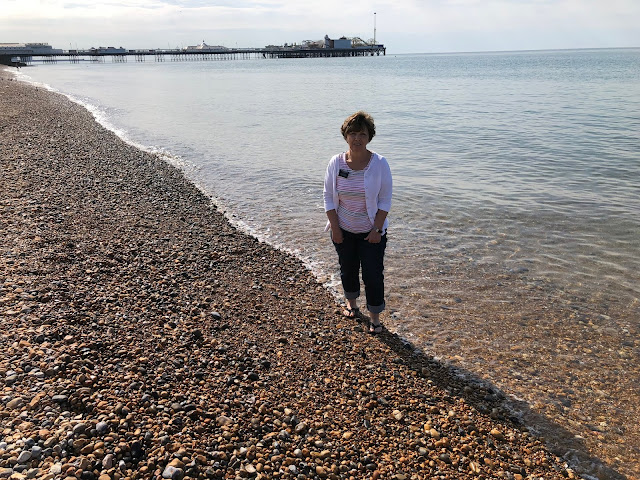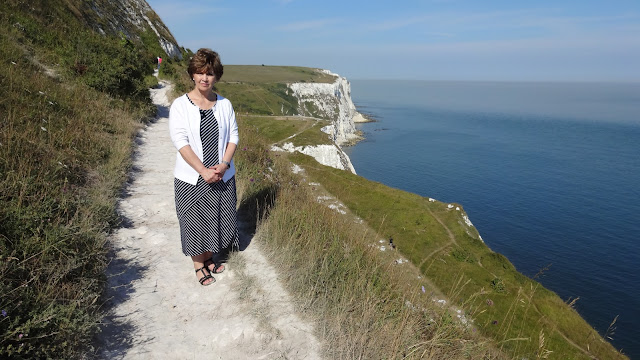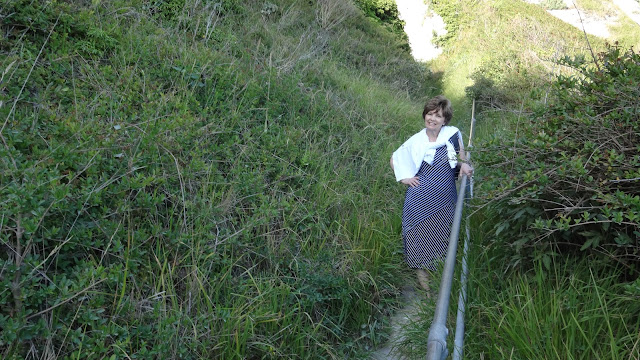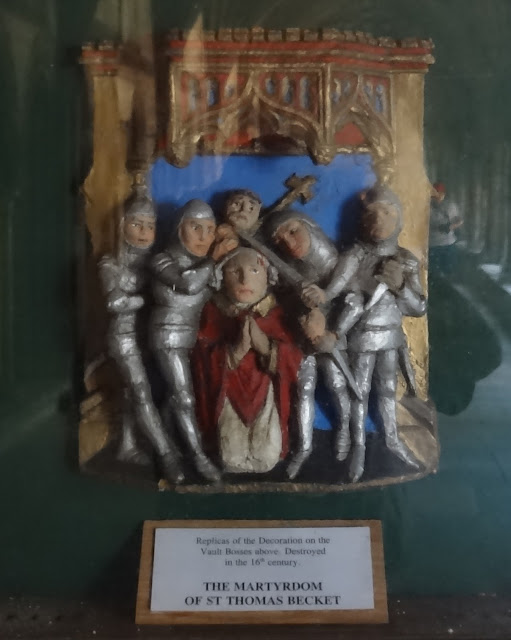July 3-16, 2018 - Baptistry, Brighton, Dover, Canterbury and Leeds Castle
During the past two weeks, we have completed our training as the baptistry coordinators and we have had some great experiences with a number of ward youth groups as well as individuals and families that come to perform vicarious baptisms and confirmations for their ancestors. Often these groups are multiple families or Stakes with multiple wards. One session we had a newly baptized young adult sister join the ward youth. She was so excited to be there. She had a wonderful experience and shared with us that her memories of grandparents, particularly her grandfather, have been flooding her mind as she has worked on putting together the information to do their work, her last name was Drummond (which is an Oklahoma name so easy for us to remember). We also had a family from Merthyr Tydfil Wales come, the Morgan family, you will recognize that name from the Abraham side of the family. They were a great family and if we both printed out our family fan we would most likely connect at some point. We loved the baptistry and look forward to that assignment again, especially since it won't be for two straight weeks.
On Monday, July 9, 2018 we drove down to the southern coast of England to the city of Brighton (often referred to as Brighton by the sea). The weather was nice and cool and we enjoyed a walk along the beach, similar to our time in Brazil when we walked along the beach in Vitória and Vilha Velha. The beach at Brighton was gravel rather than sand as you can see in the pictures below.
 |
| The beach at Brighton with the Brighton Palace Pier amusement arcade in the background. Note that the beach here is gravel rather than sand and as even southern England is about the latitude of Calgary, Canada, the water does not get very warm. |
 |
| Looking south across the English Channel from Brighton, which is about 30 miles south of the London Temple. If you zoom in, you can see the Rampion wind turbine farm which is 17 miles off-shore costing £1.3 billion for 116 monopile offshore turbines with a total capacity of 400 MW. |
The following week, we continued our adventures to the coast, this time to the famed white cliffs of Dover, which is the closest location to France. Interestingly enough, we were close enough to France that our cell-phone provider sent an automated message welcoming us to France and reminding us that our package included data and phone service in France! As we drove to Dover, we saw the signs for cars to access the Eurotunnel car train which runs between Cheriton (near Dover) and Calais, France via the channel tunnel in just 35 minutes. Once onboard passengers stay with their vehicle throughout the channel tunnel crossing in bright, air-conditioned carriages for about £49 per vehicle. We also noticed a number of signs reminding the drivers coming of the Eurotunnel to "drive on the left"! :-)
Here are a few of the pictures we took and what we learned.
 |
| Sister Burkinshaw with the white cliffs of Dover in the background. We walked about 5 miles along the edge of the cliffs. |
 |
| This picture and the next one are favorites of Sister Burkinshaw. |
 |
| Elder Burkinshaw with the white cliffs. Because of their composition (explained below), the white cliffs are nearly vertical. And because there are similar white chalk cliffs across the channel in Calias, France, it indicates that at one point in time France and England were joined (much to their respective national chagrin! :-) |
 |
The white cliffs are composed of chalk which is a form of CaCO3 called calcilte which formed with the accumulation of calcite shells from the skeletal remains of minute planktonic green algae. You can also see strata or nodules of blank flint (SiO2) as well, which is thought to be formed from the remains of silicious sponges.
|
 |
| The cliffs are bright white when the sun shines on them and stunningly beautiful against the green grass, blue ocean and gray shore below. |
 |
| In the distance, you can see the Port of Dover, which is just 21 miles across the channel from France. It is one of the world's busiest passenger ports, with 11.7 million passengers, 2.6 million lorries (18 wheel tractor trailers), 2.2 million cars and motorcycles and 80,000 coaches (passenger buses) passing through it in 2017, with an annual turnover of £58.5 million a year. The Channel Tunnel in nearby Cheriton now takes an estimated 20 million passengers and 1.6 million trucks. |
 |
| Sister Burkinshaw on the walking path with the cliffs and oceans in the background. |
 |
| The South Foreland lighthouse is located along the white cliffs and has the distinction of being the first lighthouse to use an electric light as a marker of the coast for ships at night. |
 |
| The South Foreland lighthouse. |
 |
| This picture, taken from the port, shows cliffs we walked (about 2.5 miles one-way). Note that on the left-side of the picture, there is an area of the cliffs with foliage growing and you can see a zig-zag trail which leads down to the shore. On the far right, you can see the top of the lighthouse, which was our furthest point to which we walked. |
 |
| We walked down the zig-zag trail hoping to get to the shore below. You can see the port in the distance. Unfortunately, you can also see how the last part of the trail was swept away when part of the chalk cliffs gave way. |
 |
| Here is a better picture of the trail, with a nice hand-rail (it was fairly steep) which shows where the path ended because of the chalk slide. |
 |
| Sister Burkinshaw looking down the trail before returning to the top of the cliffs. We were more formally dressed than the other hikers and not nearly as young but one of the young women hikers asked Sister Burkinshaw, in between breaths, how it was that we were able to climb so quickly! We thought (but did not say out loud) that "... all saints who remember to keep and do these sayings [the Word of Wisdom] ... shall run and not be weary, and shall walk and not faint." (D&C 89:18,20) |
Our next stop was in the ancient city of Canterbury to the Cathedral which is the Mother Church of the worldwide Anglican Communion and seat of the Archbishop of Canterbury, who is the the head of the Church of England (although Queen Elizabeth is the supreme governor of the Church).
 |
| Sister Burkinshaw in front of Canterbury Cathedral. Much of the exterior on the far end of the cathedral was under restorative construction so we focused on the Trinity Chapel side of the cathedral. |
 |
| Canterbury Cathedral was first founded in 597 AD as represented by the ancient wall in the foreground but the oldest part of the current cathedral was constructed in 1070 AD. |
 |
| Elder Burkinshaw in front of the Trinity Chapel section of the Canterbury Cathedral, which was expanded after the 1170 AD murder of Thomas Beckett as he served as Archbishop of Canterbury. A shrine was constructed for pilgrims who came to worship St. Thomas who is considered a saint by both the Catholic and Anglican churches. |
 |
| This replica of a decoration on his shrine represents the martyrdom of St. Thomas Becket. As a young man, Beckett demonstrated great administrative abilities and was named Lord Chancellor of Great Britain by King Henry II, which post even outranked that of Prime Minister. King Henry even sent his son Henry to live in Becket's household. The younger Henry was reported to have said Becket showed him more fatherly love in a day than his father did his entire life. When Beckett was consecrated as Archbishop of Canterbury, King Henry II assumed Becket would continue to put the royal government first, rather than the church. Becket however, resigned his chancellorship and made the church his sole focus. Legend has it that King Henry II, complained about Beckett in front of four of his knights, saying "Will no one rid me of this turbulent priest?" The knights took this as a mission and confronted and savagely martyred Beckett in Trinity Chapel. |
 |
| A shrine to St. Thomas Becket stood in Trinity Chapel where thousands of pilgrims came to worship him and leave many jewels and riches. "Canterbury Tales" are 24 tales of pilgrims on their way from London to the shrine of St Thomas Becket which written by Geoffrey Chaucer and have read by many students of English Literature and Philosphy. However, during the English Reformation, King Henry VIII called on Thomas Becket to answer to charges of treason against the monarchy. When Becket (obviously deceased) failed to appear, Henry VIII confiscated the riches left at the shrine (some of the jewels are part of the crown jewels kept in the Tower of London) and destroyed Becket's shrine at Canterbury Cathedral and had his bones dug up and burned - Henry VIII was not very nice!). In St.Thomas Becket's honor, a candle now burns in place of the shrine. |
 |
| Sister Burkinshaw stands in front of the "Chapel of Saints and Martyrs" which is also known as Becket's Crown, memorializing his martyrdom and that of all others. |
 |
| A professional photo of St Thomas Becket's Crown in Canterbury Cathedral which provides more detail when enlarged. Note the beautiful stained glass and altar. |
 |
| A statue of St Thomas Becket praying located in the "Chapel of Saints and Martyrs" also known as Becket's Crown. |
 |
| Trinity Chapel where the window in the center is that of the "Chapel of Saints and Martyrs" showing the beautiful ceiling as well. |
 |
| The Quire (Choir) of Trinity Chapel built in the 12th Century. |
 |
| The cloister or covered walkway surrounding the courtyard in Canterbury Cathedral. Note the beautiful and ornate stonework which dates back to the 12th Century. |
Our final stop was Leeds Castle which was a royal residence since the 13th Century and noted as the home that Henry VIII gave to his first wife, Catherine of Aragon. In more recent times, Leeds Castle was purchased in 1926 by American heiress and socialite Lady Olive Baillee. Lady Baillee restored parts of the castle to their medieval state and other parts were remodeled in the fashion of the Roaring 1920's. When she passed away in 1974, the Castle was willed to the Leeds Castle Foundation, which operates and maintains the grounds today.
 |
| Sister Burkinshaw in front of the Gunnera bushes on the Leeds Castle grounds. These leaves can grow to widths of 6 feet. In Brazil they call it giant rhubarb and use it for food. |
 |
| The gate into the Leeds Castle grounds which is built on islands in a lake formed by the River Len to the east of the village of Leeds. It has various buildings on it since 1086 and in the 13th century, became the royal residence of King Edward I. Henry VIII gave the castle to his first of his six wives, Catherine of Aragon. |
 |
| Here you can see Leeds Castle is built on an island in a lake formed by the River Len. |
 |
| Sister Burkinshaw in front of the grounds of Leeds Castle near Maidstone, Kent, England. |
 |
| Medieval armor shown at the entry to the Castle. We weren't sure if the bars were to protect the visitors or the knight in armor! ;-) |
 |
| This is the "Catherine of Aragon" bedroom. The green wall covering is actually hung so it could be moved to other castles when she traveled. |
 |
| This is the royal bathtub in the bathroom complete with curtains and buckets. |
 |
| These are the only known sculptures of Henry VIII's children. Mary was the daughter of Catherine of Aragon, Elizabeth was the daughter of Anne Boleyn and Edward was the son of Jane Seymour. |
 |
| This was Henry VIII's Dining Hall. |
 |
| Sister Burkinshaw in front of the fireplace in Henry VIII's Dining Hall. |
 |
| This was the Leeds Castle Chapel and was recently reconsecrated for Anglican Services by the Archbishop of Canterbury. |
 |
| The conference room where the Camp David Accord first began on July 18-19, 1978 at Leeds Castle. It was later signed by President Jimmy Carter, Egyptian President Anwar Sadat, and Israeli Prime Minister Menachem Begin in September 1978, establishing a framework for a historic peace treaty between Israel and Egypt . |
 |
| This was the modern (1920's) bathroom of Lady Baillee. |
 |
| Lady Baillee's blue bedroom. |
 |
| We were surprised to see the motto of Oxford University's New College here but we learned that William of Wykeham (1320-1404), the founder of New College, actually made his fortune as surveyor and chief keeper several royal residences including Leeds Castle. |
 |
| This is Lady Baillee's Yellow Sitting Room, so named for obvious reason. |
 |
| The Library. |
It is unfortunate that most of our blogs contain only information about our Monday trips that are focused on the history of England, the land of our forefathers. Our temple service on Tuesdays through Saturdays is not often referenced because the events that shape most of our experience at the London Temple is of a sacred nature that cannot be shared outside of the Temple. We love learning about this wonderful land and we gain a greater appreciation for our ancestors. This reminds us of something said by a wonderful Latter-day Saint, Carlfred Broderick, as he discussed how he excelled in scholarship. He said:
"I have attempted to achieve my mother's faith and my stepfather's scholarship. I have been richly blessed by both pursuits, but of the two, faith is at my core, rooted in my most unchallengeable experiences. Scholarship is my most valued auxiliary. Through it my mind is enriched, my relationships enlivened, my living procured, and such worldly reputation as I have, sustained. But I never forget that when the Savior greets me at the veil, it will not be my scholarship that will be examined." (Carlfred Broderick, My Parents Married on a Dare, Deseret Book, 1996, p. 50)
Love,
Elder and Sister Burkinshaw












































No comments:
Post a Comment